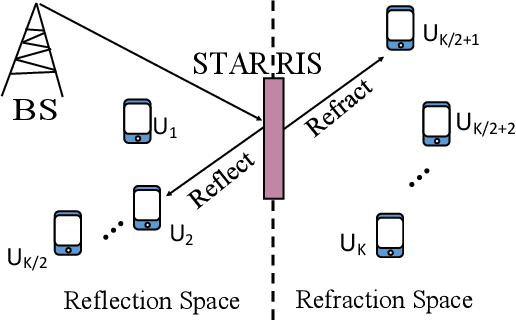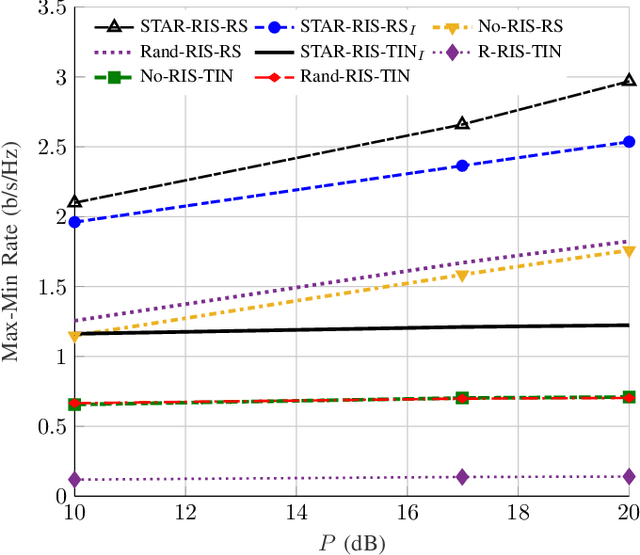Jesús Gutiérrez
URLLC Networks enabled by STAR-RIS, Rate Splitting, and Multiple Antennas
Nov 07, 2024

Abstract:The challenges in dense ultra-reliable low-latency communication networks to deliver the required service to multiple devices are addressed by three main technologies: multiple antennas at the base station (MISO), rate splitting multiple access (RSMA) with private and common message encoding, and simultaneously transmitting and reflecting reconfigurable intelligent surfaces (STAR-RIS). Careful resource allocation, encompassing beamforming and RIS optimization, is required to exploit the synergy between the three. We propose an alternating optimization-based algorithm, relying on minorization-maximization. Numerical results show that the achievable second-order max-min rates of the proposed scheme outperform the baselines significantly. MISO, RSMA, and STAR-RIS all contribute to enabling ultra-reliable low-latency communication (URLLC).
Energy Efficiency Comparison of RIS Architectures in MISO Broadcast Channels
Aug 08, 2024

Abstract:In this paper, we develop energy-efficient schemes for multi-user multiple-input single-output (MISO) broadcast channels (BCs), assisted by reconfigurable intelligent surfaces (RISs). To this end, we consider three architectures of RIS: locally passive diagonal (LP-D), globally passive diagonal (GP-D), and globally passive beyond diagonal (GP-BD). In a globally passive RIS, the power of the output signal of the RIS is not greater than its input power, but some RIS elements can amplify the signal. In a locally passive RIS, every element cannot amplify the incident signal. We show that these RIS architectures can substantially improve energy efficiency (EE) if the static power of the RIS elements is not too high. Moreover, GP-BD RIS, which has a higher complexity and static power than LP-D RIS and GP-D RIS, provides better spectral efficiency, but its EE performance highly depends on the static power consumption and may be worse than its diagonal counterparts.
MIMO Capacity Maximization with Beyond-Diagonal RIS
Jun 04, 2024



Abstract:This paper addresses the problem of maximizing the capacity of a multiple-input multiple-output (MIMO) link assisted by a beyond-diagonal reconfigurable intelligent surface (BD-RIS). We maximize the capacity by alternately optimizing the transmit covariance matrix, and the BD-RIS scattering matrix, which, according to network theory, should be unitary and symmetric. These constraints make the optimization of BD-RIS more challenging than that of diagonal RIS. To find a stationary point of the capacity we maximize a sequence of quadratic problems in the manifold of unitary matrices. This leads to an efficient algorithm that always improves the capacity obtained by a diagonal RIS. Through simulation examples, we study the capacity improvement provided by a passive BD-RIS architecture over the conventional RIS model in which the phase shift matrix is diagonal.
Objective quality assessment of medical images and videos: Review and challenges
Dec 14, 2022Abstract:Quality assessment is a key element for the evaluation of hardware and software involved in image and video acquisition, processing, and visualization. In the medical field, user-based quality assessment is still considered more reliable than objective methods, which allow the implementation of automated and more efficient solutions. Regardless of increasing research in this topic in the last decade, defining quality standards for medical content remains a non-trivial task, as the focus should be on the diagnostic value assessed from expert viewers rather than the perceived quality from na\"{i}ve viewers, and objective quality metrics should aim at estimating the first rather than the latter. In this paper, we present a survey of methodologies used for the objective quality assessment of medical images and videos, dividing them into visual quality-based and task-based approaches. Visual quality based methods compute a quality index directly from visual attributes, while task-based methods, being increasingly explored, measure the impact of quality impairments on the performance of a specific task. A discussion on the limitations of state-of-the-art research on this topic is also provided, along with future challenges to be addressed.
DNN-assisted Particle-based Bayesian Joint Synchronization and Localization
Sep 29, 2021



Abstract:In this work, we propose a Deep neural network-assisted Particle Filter-based (DePF) approach to address the Mobile User (MU) joint synchronization and localization (sync\&loc) problem in ultra dense networks. In particular, DePF deploys an asymmetric time-stamp exchange mechanism between the MUs and the Access Points (APs), which, traditionally, provides us with information about the MUs' clock offset and skew. However, information about the distance between an AP and an MU is also intrinsic to the propagation delay experienced by exchanged time-stamps. In addition, to estimate the angle of arrival of the received synchronization packet, DePF draws on the multiple signal classification algorithm that is fed by Channel Impulse Response (CIR) experienced by the sync packets. The CIR is also leveraged on to determine the link condition, i.e. Line-of-Sight (LoS) or Non-LoS. Finally, to perform joint sync\&loc, DePF capitalizes on particle Gaussian mixtures that allow for a hybrid particle-based and parametric Bayesian Recursive Filtering (BRF) fusion of the aforementioned pieces of information and thus jointly estimate the position and clock parameters of the MUs. The simulation results verifies the superiority of the proposed algorithm over the state-of-the-art schemes, especially that of Extended Kalman filter- and linearized BRF-based joint sync\&loc. In particular, only drawing on the synchronization time-stamp exchange and CIRs, for 90$\%$of the cases, the absolute position and clock offset estimation error remain below 1 meter and 2 nanoseconds, respectively.
Prediction of the Influence of Navigation Scan-path on Perceived Quality of Free-Viewpoint Videos
Oct 10, 2018



Abstract:Free-Viewpoint Video (FVV) systems allow the viewers to freely change the viewpoints of the scene. In such systems, view synthesis and compression are the two main sources of artifacts influencing the perceived quality. To assess this influence, quality evaluation studies are often carried out using conventional displays and generating predefined navigation trajectories mimicking the possible movement of the viewers when exploring the content. Nevertheless, as different trajectories may lead to different conclusions in terms of visual quality when benchmarking the performance of the systems, methods to identify critical trajectories are needed. This paper aims at exploring the impact of exploration trajectories (defined as Hypothetical Rendering Trajectories: HRT) on perceived quality of FVV subjectively and objectively, providing two main contributions. Firstly, a subjective assessment test including different HRTs was carried out and analyzed. The results demonstrate and quantify the influence of HRT in the perceived quality. Secondly, we propose a new objective video quality assessment measure to objectively predict the impact of HRT. This measure, based on Sketch-Token representation, models how the categories of the contours change spatially and temporally from a higher semantic level. Performance in comparison with existing quality metrics for FVV, highlight promising results for automatic detection of most critical HRTs for the benchmark of immersive systems.
 Add to Chrome
Add to Chrome Add to Firefox
Add to Firefox Add to Edge
Add to Edge